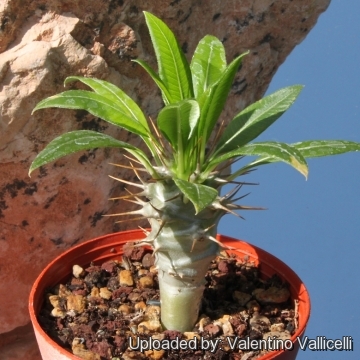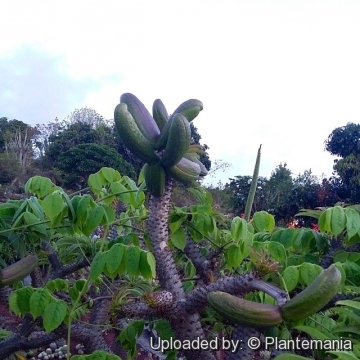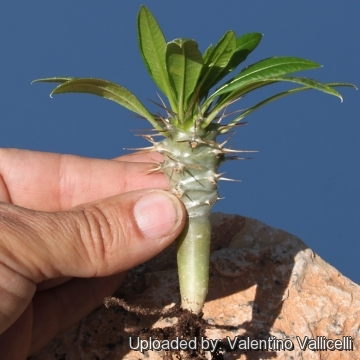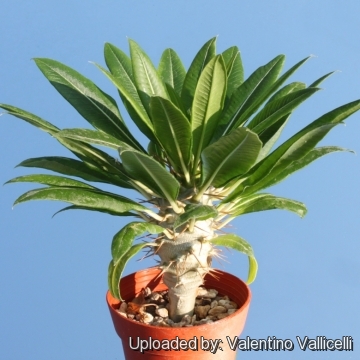Accepted Scientific Name: Pachypodium lamerei Drake
Bull. Mus. Hist. Nat. (Paris) v. 308.

Pachypodium lamerei var. ramosum Photo by: © Plantemania
Origin and Habitat: South Madagascar.
Synonyms:
See all synonyms of Pachypodium lamerei
Common Names include:
ENGLISH: Branched Madagascar palm
FRENCH (Français): Pachypodium branchu de Madagascar
Description: Pachypodium lamereiSN|10823]]SN|10823]] var. ramosum is a local form of Pachypodium lamereiSN|10823]]SN|10823]]. It distinguishes mostly by a dwarf growth habit. It has also more rounded corolla lobes, gradually narrowed towards the base 4-5 cm long and has glabrous leaves (never tomentose below).
Habit: It is a semidecidous or deciduous semitropical succulent stemmed tree, 2,5 m tall, or more with optimal conditions. (As a houseplant, it is much smaller) In cultivation it is often marketed as the "Madagascar Palm", despite in not being a palm at all. The Pachypodium tends to lose its leave and go dormant in winter in temperate climate areas.
Stem: It has an intensely spiny grey and very attractive and stout trunk, which is solitary or dichotomously branched and the base is spindle-shaped. The stem are covered by tough, glossy bark and spirally set low tubercles. Branching starts only after the first flowering which can be expected once the plants are about 1,5-1,8 m tall.
Thorn: 3 on each tubercle, the 2 divergent lateral 1-2,5(-6) cm long, with a shorter ascending central.
Leaves: 20-35 cm long, lanceloted to narrowly elliptic, glabrous (not tomentose below), simple, glossy green, margins slightly wavy scattered along the branches and arranged spirally mostly just at the top of the plant.
Roots: Fine, delicate (older plants can have huge rootballs, though).
Inflorescence: Terminal with stout branching peduncle 5-20 cm long.
Flowers: The flowers are 4-6 cm long and 8-10 cm in diameter, salverform, white with yellow centre, attractive and nice smelling. Corolla lobes rounded 4-5 cm long, gradually narrowed towards the base.
Blooming season: Only mature plants bloom (1,8 m tall or more). It flowers in spring to early summer, on and off through all the warm months.
Fruits and seeds: It produces seed pods that look like bananas. 15-20 cm long. Left alone, they eventually open along the seam revealing great numbers of white-winged seeds.
Seeds: Simple, green, finely tomentose below, lanceloted arranged spirally mostly just at the top of the plant.
Roots: Fine, delicate (older plants can have huge rootballs, though).
Flowers: 15 mm long, brown.
Bibliography: Major references and further lectures
1) Urs Eggli "Illustrated Handbook of Succulent Plants: Dicotyledons" Springer, 2002
2) Hilary Bradt "Madagascar" Bradt Travel Guides, 2011
3) Gordon D. Rowley "Pachypodium and Adenium" Cactus File, Cirio Pub. Services, 1999
4) Papanarivo SHJV, Lavranos JJ, Leeuwenberg AJM, Pachypodium (Apocynaceae): Taxonomy, Habitats and Cultivation, CRC Press, 1999
5) Drake del Castillo, E. . Note sur quelques plantes de la region Sud et Sud-Ouest de Madagascar. Bull. Mus. Hist. Nat. (Paris) 5: 305–309. 1899
6) Haude, M. Pachypodium Lindl. - familie Apocynaceae. Kakteen And. Sukk. 22(4): 122–127.1987.
7) Markgraf, F. Apocynacees. Fl. Madagasc. 169: 1–317. 1976
8) Perrier de la Bathie, H. Les Pachypodium de Madagascar. Bull. Soc. Bot. France 81: 297–318. 1934.
9) Pichon, M. Classification des Apocynacées. Mém. Inst. Sci. Madagascar, Sér. B, Biol. Vég. 2(1): 45–140.1949.
10)Schatz, G. E., S. Andriambololonera, Andrianarivelo, M. W. Callmander, Faranirina, P. P. Lowry, P. B. Phillipson, Rabarimanarivo, J. I. Raharilala, Rajaonary, Rakotonirina, R. H. Ramananjanahary, B. Ramandimbisoa, A. Randrianasolo, N. Ravololomanana, Z.S. Rogers, C.M. Taylor & G. A. Wahlert. Catalogue of the Vascular Plants of Madagascar. Monogr. Syst. Bot. Missouri Bot. Gard. 2011.
 Pachypodium lamerei var. ramosum Photo by: Valentino Vallicelli
Pachypodium lamerei var. ramosum Photo by: Valentino Vallicelli Pachypodium lamerei ramosum (fruits c. 20 x 4 cm) Photo by: © Plantemania
Pachypodium lamerei ramosum (fruits c. 20 x 4 cm) Photo by: © Plantemania Pachypodium lamerei var. ramosum Photo by: Valentino Vallicelli
Pachypodium lamerei var. ramosum Photo by: Valentino Vallicelli Pachypodium lamerei var. ramosum Photo by: Valentino Vallicelli
Pachypodium lamerei var. ramosum Photo by: Valentino VallicelliCultivation and Propagation: Is fairly easy to grow both indoors, as well as outdoors in warm climates and can grow at about 10cm a year. In the winters it is deciduous, except in very tropical areas. Needs a draining cactus potting mix and regular water when the plant has leaves, contrary to popular belief, it likes a lot of water in the warm summers, as long as it's planted in a very well draining soil. Indoors it is best to err on the dry side, or it is prone to rot. It like full sun to light shade with warm temperatures.
It is a fairly slow growing plant, but in 10 years it can easily outgrow its indoor location, requiring a 'pruning'. Though branching is usually a response to naturaly injury, or something that happens in older specimens, one can stimulate branching by cutting off its top. It has amazing regenerative properties.
Repot the plant every 3 years; this is quite tricky given all the spines. The best way is to wrap several layers of newspaper around the trunk where it is to be handled.
Propagation: Seeds or division.
Fresh seeds results in a remarkable yield of new plants, perhaps 90%, Soak seeds in warm water for 24 hours before sowing in moist sand. Seed start sprouting in just 3-4 days ( but continue to germinate erratically for about 6 month) Pachypodium lamereiSN|10823]]SN|10823]] are also propagated by removal of small offshoots that grow at the base of the old plant. Carefully break off the offshoots, they should be allowed to dry for 5 to 8 days before potting up.














